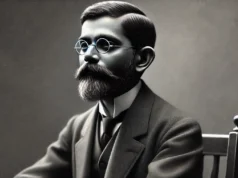
In John chapters 13–17 we have what is called ‘the final discourse’. Chapter 13 opens with these words: ‘Jesus knew that His hour had come and He should depart from this world to the Father’ (13:1).
Before his anticipated death he engaged in a final moment of private teaching with the men whom the Father had given to Him as His apostles. He knew that He would soon be glorified in heaven with his Father.
We are reminded in chapter 13 of the fervent love Jesus had for those whom the Father had given him: ‘having loved His own who were in the world, He loved them to the end’ (13:1).
This most tender and affectionate statement is a fitting introduction to all that would be said by our Saviour before He hung on the cross as Substitute and Redeemer (15:13). He would command them to ‘love one another’ (13:34), for they needed to put on Christ and take up their cross daily and follow Him.
The phrase ‘having loved His own’ describes the objects of His love as belonging to him. This theme will continually come to the fore in our study.
Jesus Christ prays for His Church
In this remarkable prayer, Jesus Christ prays for His church: it is a family prayer. He does not pray for the world but for the apostles and all the people of God, prefacing His intercessions by revealing something about His relationship with God his Father. He uses the word ‘Father’ six times, twice with preceding adjectives—‘Holy Father’ (v. 11) and ‘righteous Father’ (v. 25)—and four times without (vv. 1, 5, 21, 24).
In the Holy Trinity, God is Father to Christ in an eternal and unique relationship. It is a Fatherhood that is exclusively Trinitarian. The word ‘world’ (kosmos) is used eighteen times in Christ’s prayer, and the personal pronouns ‘they’, ‘them’ and ‘those’, referring to the disciples, at least twenty-five times.
The topics covered are varied and profound. They include the Son’s Divinity and Pre-Existence, the Incarnation, the Impeccability of Jesus Christ, the finished work of Christ, unconditional election, salvation, adoption, Christian discipleship and perseverance, sanctification, the unity of the body of Christ, true ecumenism and the love of Christ for His church.
Jesus’s prayer reveals both his deity and humanity. It is full of references to His eternal union with the Father in the Godhead but also gives insight into His Messianic role as the Son of Man. There has been much controversy about the two natures of Christ.
The issue was settled theologically in AD 325 with the Creed of Nicaea, which declared the Son to be ‘of one substance with the Father’. The doctrine was strengthened at the Council of Chalcedon in AD 451, when Christ was recognized to be ‘in two natures, without confusion, without change, without division, without separation’.
Thus He was understood as being 100 per cent divine and 100 per cent human without confusion of substance. Throughout history, many groups have challenged this teaching, such as the Gnostic philosophers in the post-apostolic days of the early church, some of whose work is known to us in the Gospels of Thomas and Judas.
Today, such groups include the Jehovah’s Witnesses, who believe that Christ is a created super-being. Gnostic ideas have also been popularized this century through the writings of author Dan Brown, especially in his book The Da Vinci Code, and they are increasingly being used by both liberal Christian scholars and Islamic writers to bring into question the Bible’s record of the historical Jesus.
Even John Lennon of The Beatles fame was confused. Lennon said, ‘The only true Christians were the Gnostics, who believe in self-knowledge, i.e. becoming Christ themselves, reaching the Christ within. (!)’
However, a true understanding of the High-Priestly prayer in John 17 is dependent upon our awareness of the two natures of Jesus Christ. This doctrine is, of course, foolishness to the Gentiles and an obstacle to the Jews (1 Cor. 1:23).
Christians believe that Jesus Christ is ‘the image of the invisible God’ (Col. 1:15), not only because He is a man made in the image of God (Gen. 1:26–27; 1 Cor 11:7), but also because He is in His very nature God. As the Epistle to the Hebrews puts it, He is ‘the brightness of [God’s] glory and the express image of [God’s] person’ (Heb. 1:3).
Rev Ian S McNaughton is presently serving as the Vice-Chairman of Barnabas Fund in the UK.
Photo by Brad Mann on Unsplash
For Other Articles by Rev Ian S McNaughton
Listening to Jesus Pray – Part 1









